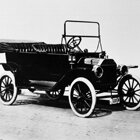
Jim Mone/AP
Assistant U.S. Attorney General Kent Frizzell, right, listens to AIM leaders sit by in tepee prior to signing of peace settlement, April 5, 1973.
Assistant U.S. Attorney General Kent Frizzell, right, listens to AIM leaders sit by in tepee prior to signing of peace settlement, April 5, 1973.
On This Day: Wounded Knee Standoff Ends
by findingDulcinea Staff
On May 8, 1973, members of the militant American Indian Movement who had held the South Dakota hamlet of Wounded Knee surrendered to federal agents after a 10-week standoff.
The Wounded Knee Incident
The Wounded Knee standoff began over a dispute on the Pine Ridge Reservation in southwestern South Dakota. Members of the Oglala Lakota (Sioux) tribe attempted to impeach Oglala tribal chairman Richard “Dick” Wilson, who they accused of being corrupt, authoritarian and biased against full-blooded and traditional Indians.
When the impeachment charges were dropped, the Oglala brought in AIM militants to aid their cause. On Feb. 27, about 200 armed AIM activists and members of the Oglala seized Wounded Knee on the Pine Ridge Reservation. The activists demanded the removal of Wilson, a federal investigation into corruption on reservations and inquiries into broken treaties between Indians and the United States government.
Their cause received a great deal of media coverage, as reporters flooded to Wounded Knee. Actor Marlon Brando sent an Apache woman to accept his Academy Award and promised to visit Wounded Knee, bringing further attention to the incident.
The May 9 New York Times described the standoff: “For many days, except for the danger involved, the seizure was like some strange carnival with hundreds of policemen surrounding the Indians, who staged and then restaged events for television camera crews in their mobile campers. Chartered planes swooped in and out, some dropping supplies to the town. … Negotiations, sometimes held by an old teepee, dragged for weeks. A Federal negotiator smoked a peace pipe. Hostages were released. A tentative agreement was set April 5, but then collapsed.”
There were frequent shoot-outs at night between the Indians and federal agents positioned around Wounded Knee. Two Indians were killed in shoot-outs and one federal agent was paralyzed. The death of the second Indian, Oglala Buddy Lamont, prompted many Oglala to seek an end to the standoff.
The end of the Wounded Knee incident was only the beginning of prolonged violence on Pine Ridge. Dick Wilson’s Guardians of the Oglala Nation (GOONs) carried out attacks on political opponents, as more than 60 supporters of AIM were killed in the next three years.
The Wounded Knee incident did not bring about immediate reforms sought by the AIM activists, though it did succeed to bringing national attention to plight of American Indians and promoting Indian cultural identity.
When the impeachment charges were dropped, the Oglala brought in AIM militants to aid their cause. On Feb. 27, about 200 armed AIM activists and members of the Oglala seized Wounded Knee on the Pine Ridge Reservation. The activists demanded the removal of Wilson, a federal investigation into corruption on reservations and inquiries into broken treaties between Indians and the United States government.
Their cause received a great deal of media coverage, as reporters flooded to Wounded Knee. Actor Marlon Brando sent an Apache woman to accept his Academy Award and promised to visit Wounded Knee, bringing further attention to the incident.
The May 9 New York Times described the standoff: “For many days, except for the danger involved, the seizure was like some strange carnival with hundreds of policemen surrounding the Indians, who staged and then restaged events for television camera crews in their mobile campers. Chartered planes swooped in and out, some dropping supplies to the town. … Negotiations, sometimes held by an old teepee, dragged for weeks. A Federal negotiator smoked a peace pipe. Hostages were released. A tentative agreement was set April 5, but then collapsed.”
There were frequent shoot-outs at night between the Indians and federal agents positioned around Wounded Knee. Two Indians were killed in shoot-outs and one federal agent was paralyzed. The death of the second Indian, Oglala Buddy Lamont, prompted many Oglala to seek an end to the standoff.
The end of the Wounded Knee incident was only the beginning of prolonged violence on Pine Ridge. Dick Wilson’s Guardians of the Oglala Nation (GOONs) carried out attacks on political opponents, as more than 60 supporters of AIM were killed in the next three years.
The Wounded Knee incident did not bring about immediate reforms sought by the AIM activists, though it did succeed to bringing national attention to plight of American Indians and promoting Indian cultural identity.
Wounded Knee Resources
An episode of PBS’ “We Shall Remain” examines the Wounded Knee incident in depth. The documentary can be viewed online.
Read the U.S. Marshals Service’s account of the incident.
Read the American Indian Cultural Support’s timeline of the incident and its archive of documents related to the incident.
Read the U.S. Marshals Service’s account of the incident.
Read the American Indian Cultural Support’s timeline of the incident and its archive of documents related to the incident.
Historical Background: Wounded Knee Massacre
Wounded Knee held a special significance for the Oglala and all American Indians. It was the site of the 1890 Wounded Knee Massacre of 200-300 Sioux Indians by federal forces, considered to be the last major conflict of the Indian Wars.

























